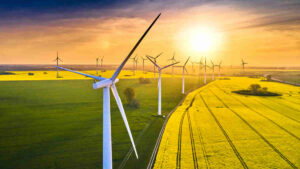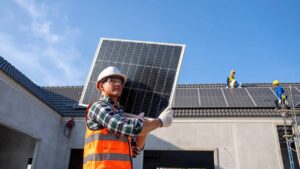ASX battery storage plays such as Redflow are leading the world; ScoMo’s Budget acts like they don’t exist

Ooh, political statement pic. Picture: Getty Images
Zinc bromine flow battery specialist Redflow (ASX:RFX) recently took to Youtube to showcase its new megawatt-scale Energy Pod Z energy storage module for grid-scale applications.
In the video, the company’s managing director Tim Harris and its largest shareholder (and Internode founder) Simon Hackett discuss the merits of the system, which integrates 16 Redflow batteries with world-leading power conversion technology.
However, the new energy storage module and other renewable energy and battery storage technologies are the losers in the latest Australian Federal Budget, which has allocated no direct funding for renewables save a $30m commitment over the next year for a battery and microgrid project in the Northern Territory.
Rather, the Budget has set aside $643.4m over the next four years for ‘low emissions’ technology with $275m to go into developing four hydrogen production hubs and another $237m into controversial carbon capture and storage developments.
This is in line with the Morrison government’s seeming dislike for renewables, an ideology that was recently demonstrated when Federal Minister for Resources, Water and Northern Australia Keith Pitt blocked public funding for a windfarm and battery project in northern Queensland.
He added in his reasoning for the move that widespread deployment of mature technologies including wind and solar energy would be mainly driven by the private sector.
The Australian Budget’s snubbing of renewables drew predictable responses from environmental groups with the Clean Energy Council saying that it was another missed opportunity for the Government to embrace renewable energy and use it to drive job creation and economic recovery.
Its chief executive Kane Thornton said it was disappointing that despite Infrastructure Australia identifying the need for major transmission upgrades to supply network access to renewable energy zones, there was a lack of investment in this area.
“The lack of transmission investment is now one of the most critical challenges facing Australia’s energy industry. It’s disappointing that in a ‘nation-building’ infrastructure budget, upgrades that will enable the access and security of clean, low-cost power have not been prioritised,” he added.
All was not lost for the renewables sector though with the extension of instant asset write-off tax breaks for businesses expected to help encourage the uptake of commercial solar systems.
Australian Budget pumps more into gas
Separately, another $58.6m has been allocated to the Federal government’s gas-fired recovery plans that ostensibly seek to pave the way for the development of more gas projects in a bid to lower prices.
This includes $6.2m to further develop the Wallumbilla gas supply hub and $5m for the government to work with Queensland on the feasibility of a new pipeline to link the North Bowen Basin to the east coast market.
Energy Minister Angus Taylor said that taxpayer-funded investments were required to ensure there was sufficient supply of gas on the east coast of Australia.
“Without action to address supply, industry and households will be faced with higher prices, disruptions in supply and unplanned outages,” he added.
However, the Climate Council noted that gas was already being out-competed by renewable energy and that its gas investments were a waste of taxpayer money.
“This is yet another attempt from the Morrison Government to prop-up its expensive and unnecessary ‘gas-fired recovery’,” senior researcher Tim Baxter said.
Related Topics
UNLOCK INSIGHTS
Discover the untold stories of emerging ASX stocks.
Daily news and expert analysis, it's free to subscribe.
By proceeding, you confirm you understand that we handle personal information in accordance with our Privacy Policy.








